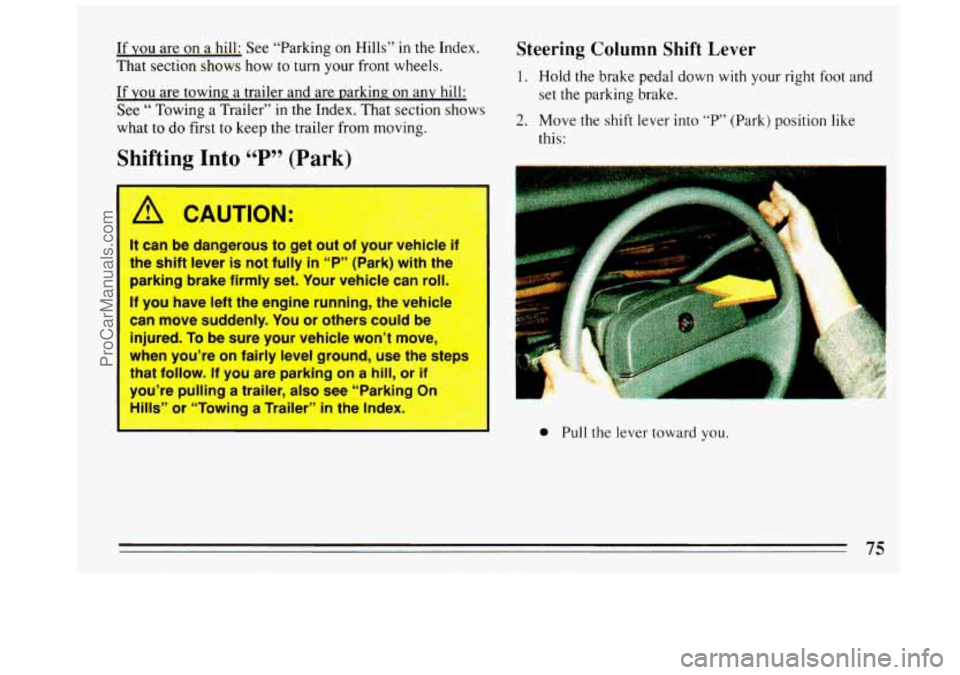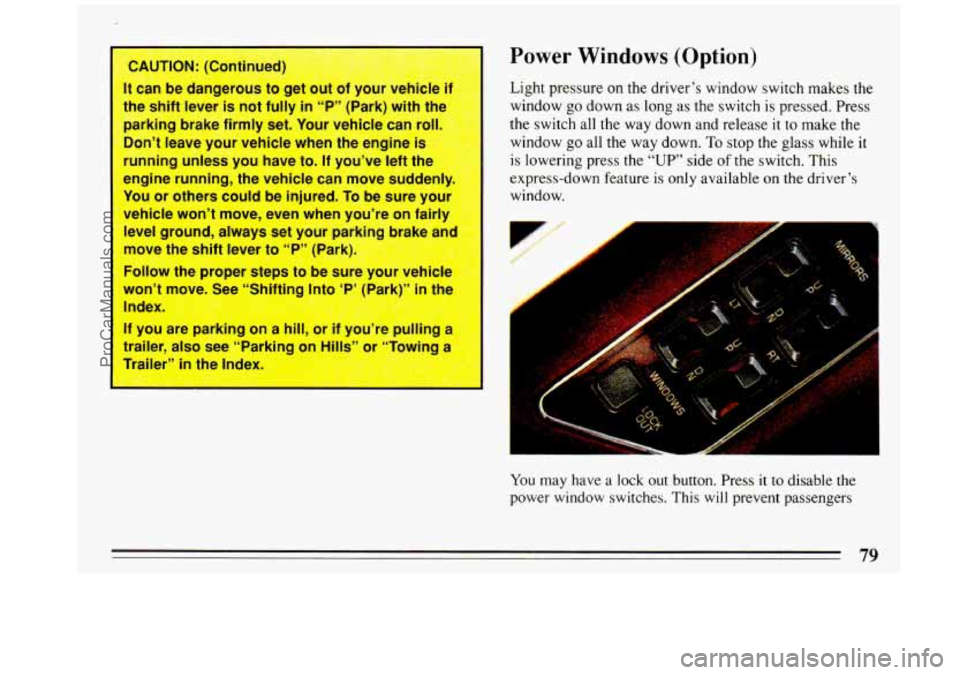Page 14 of 308
Vehicle Symbols
These are some of the symbols you will find on your vehicle.
For example,
these symbols
are used on an
original battery:
POSSIBLE A
CAUTION
INJURY
PROTECT EYES BY
SHIELDING
CAUSTIC
BURNS AVOID
SPARKS
OR
FLAMES
SPARK
OR ,\I/,
COULD FLAME
EXPLODE BATTERY
These symbols
are important
for you and
your passengers
whenever your
vehicle
is
driven:
DOOR LOCK
UNLOCK
e
e
BELTS 4
POWER
WINDOW
These symbols
have
to do with
your lights:
SIGNALS e @
TURN
HIGH BEAM
OR = =o
FOG LAMPS $0
These symbols
are on some
of
your controls:
WINDSHIELD ' ' ' 0- 0-
WASHER
WINDSHIELD WASHER
WINDOW
DEFOGGER
VENTILATING FAN
HEADLAMP
-
WIPER
WASHER
Q
These symbols
are
used on
warning and
indicator lights:
COOLANT F-
TEMP --
ENGINE
CHARGING
I-1
BATTERY SYSTEM
BRAKE
(0)
RADIATOR 0
COOLANT
FUEL
ENGINE OIL w,
PRESSURE
TEMP
OIL &b
ANTILOCK (a)
BRAKE
Here are some
other symbols
you may see:
FUSE
RADIO
VOLUME
CONDITIONING
AIR 43
HATCHBACK TRUNK
RELEASE
t LIGHTER
HORN
SPEAKER
12
ProCarManuals.com
Page 67 of 308

Parking Lots: If you park in a lot where someone will
be watching your vehicle, it’s best
to lock it up and take
your keys. But what
if you have to leave your ignition
key? What if
you have to leave something valuable in
your vehicle?
0 Put your valuables in a storage area, like your trunk
or glove box.
0 Lock the glove box.
0 Lock all the doors except the driver’s.
0 Then take the door key with you.
New Vehicle ‘LBreak-In99
Your modern Buick doesn’t need an elaborate
“break-in.” But
it will perform better
run if you follow these guidelines:
Don’t drive at any one speed -- fast or sin
-- for the first 500 miles (804. km,)Jon’+ .,,, ii’ ’
make full-throttle starts.
Avoid making hard stops for the
first 200
miles (322 km) or so. During this time your
new brake linings aren’t yet broken
in. Hard
stops with new linings can mean premature
wear and earlier replacement.
Follow this
“breaking-in” guideline every time you get
lew brake linings.
.ti“”.: .-,i- t.,/ +
65
ProCarManuals.com
Page 73 of 308
Automatic Transaxle
1
1%.
There are several different positions for your shift lever.
P (Park)
This locks your front wheels. It’s the best position to
use when you start your engine because your vehicle
can’t move easily.
A CAUTION:
It is dangerous to get out of your vehicle if the%
shift lever is not fully in “P” (Park) with the
parking brake firmly set. Your vehicle can roll.
Don’t leave your vehicle when the engine
is
running unless you have to. If you have left tht
engine running, the vehicle can move suddenly.
You or others could be injured. To be sure your
vehicle won’t move, when you’re on fairly level
ground, always set your parking brake and move
the shift lever to “P” (Park).
See “Shifting Into “P” (Park)”
in tl Index. I1 ;
are parking on a hill, or if you’re puliing a traller,
also see“Parking on Hills” or “Towing a Trailer”
R (Reverse)
Use this gear to back up.
71
ProCarManuals.com
Page 75 of 308
- When towing a trailer, so there.is less shifting
- When going down a steep hill between gears
’ 2 (Second Gear)
This position gives you more power but lower fuel
economy. You can use
2 on hills. It can help
control your speed as you go down steep mountain
roads, but then you would also want
to use your
brakes
off and on.
bb 97
miles (8 km), or at speeds over 55 mph (88 kmih),
or you can damage your transaxle. Use
‘@” or
“D” as much as possible.
Don’t shift into
“2” unless you are going slower
1 (First Gear)
This position gives you even,more power (but lower
fuel economy) than
“2.” You can use it on very steep
hills, or in deep snow
or mud. If the selector lever is
put’in
“1 ,” the transaxle won’t shift into first gear
until the vehicle
is going slowly enough.
Maximum engine speed
is limited when the transaxle is
in “D” (Drive) or
“N” (Neutral) to protect driveline
components from improper operation.
73
ProCarManuals.com
Page 76 of 308
Pump-to-Set Parking Brake
The parking brake uses the brakes on the rear wheels.
To set the parking brake:
Hold the regular brake pedal down with your right foot.
Pump your parking brake pedal several times with your
left foot until the pedal feels firm. If the ignition is on,
the brake system warning light will come on.
Over time, more pumps may be needed to set the
parking brake firmly.
If it ever takes more than two full
pumps, have the brake system adjusted by your dealer.
To release the parking brake:
Hold the regular brake pedal down. Pull the brake
release lever.
.
NOTIC% I
Driving with the parking brake on can cause your
rear brakes to overheat. You may have to replace
your vehicle. them, and
you could also damage
74
ProCarManuals.com
Page 77 of 308

If YOU are on a hill: See “Parking on Hills” in the Index.
That section shows how to turn your front wheels.
If
you are towing. a trailer and are parking on any hill:
See
“ Towing a Trailer” in the Index. That section shows
what to do first to keep the trailer from moving.
Shifting Into 66 P 99 (P-k)
It can be dangerous to ger out of your vehicle if
the shift lever is not fully
in “P” (Park) with the
parking brake firmly set. Your vehicle can rol~
If you have left the engine running, the vehicl
can move suddenly. You or others could be
injured.
To be sure your vehicle won’t move,
when you’re on fairly level ground, use the
steps
that follow. If you are parking on a hill, or if
you’re pulling a trailer, also see “Parkinc 3n
Hills” 2r “Towing a Traile-” ’- the lrT’?x.
Steering Column Shift Lever
1. Hold the brake pedal down with your right foot and
set the parking brake.
2. Move the shift lever into “P77 (Park) position like
this:
0 Pull the lever toward you.
75
ProCarManuals.com
Page 78 of 308
Move the lever up as far as it will go.
3. Move the ignition key to “Lock.”
4. Remove the key and take it with you. If you can
walk away from your vehicle with the ignition key in
your hand, your vehicle is in “P” (Park).
Console Shift Lever
1. Hold the brake pedal down with your right foot and
set the parking brake.
2. Move the shift lever into “P’ (Park) position like
this:
Hold in the button on the lever, and push the
lever all the way toward the front
of your vehicle.
-II
3. Move the ignition key to “Lock.”
4. Remove the key and take it with you. If you can
walk away from your vehicle with the ignition key
in
your hand, your vehicle is in “P’ (Park).
76
ProCarManuals.com
Page 81 of 308

f
-
CAUTION: (Continued)
It can be dangerous to get out of your vehicle if
the shift lever
is not fully in “P” (Park) with the
parking brake firmly set. Your vehicle can roll.
Don’t leave your vehicle when the engine is
running unless you have to. If you’ve left the
engine
running, the vehicle can move suddenly.
You or others could be injured. To be sure your
vehicle won’t move, even when you’re
on fairly
level ground, always set your parking brake and
-we the shift lever to “P” (Park)
Follow the proper steps to be sure your vehicle
won’t move. See “Shifting Into ‘P’ (Park)”
in the
Index,
If you are parking on a hill, or if you’re pulling a
iler, also see “Parking on Hills” or “Towing a
ailer”
in the Index.
Power Windows (Option)
Light pressure on the driver’s window switch makes the
window go down as long as the switch is pressed. Press
the switch all the way down and release
it to make the
window go all the way down. To stop the glass while
it
is lowering press the “UP” side of the switch. This
express-down feature is only available
on the driver’s
window.
You may nave a lock out button. Press it to disable the
power window switches. This will prevent passengers
79
-
ProCarManuals.com